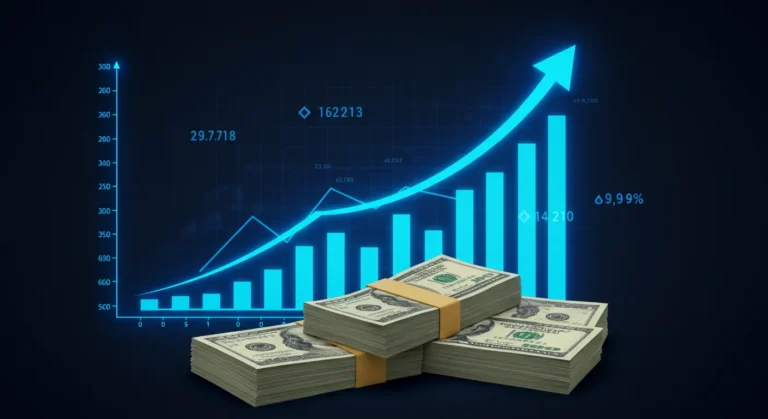How much will I have if I invest $500 a month for 20 years? It’s a question that often lingers in the minds of many aspiring investors, especially those looking to secure a solid financial future. Whether you’re just starting your career, planning for retirement, or saving for a dream vacation, understanding the potential of this investment can be a game changer. With the power of compounding interest on your side, the results can be quite remarkable.
Imagine setting aside a relatively modest sum each month and watching it grow over time. As we dive into this topic, I hope to clarify not only how much your investment can accumulate but also the factors that can influence your return. This journey will not only equip you with the necessary knowledge but also empower you to make informed financial decisions. Let’s explore the world of investing and see what happens with that $500 a month over the span of two decades.
Investing is about patience, strategy, and understanding the forces at play in the financial markets. Whether you’re tempted by stocks, bonds, or real estate, appreciating the journey of your investment is crucial. I’ll share critical insights into various investment avenues and their impact on your monthly contributions. So, grab a cup of coffee, and let’s get started!
By the end of our discussion, you’ll not only grasp the potential outcome of investing $500 monthly but also feel inspired and informed to start or enhance your investment journey. So, how much could you actually end up with?
Understanding Compounding Interest
First things first, let’s talk about compounding interest. This isn’t just a buzzword; it’s the engine that drives your investment growth. Compounding interest means that you earn interest not only on your initial investment but also on the interest that accumulates over time.
The Power of Time
In the context of investing, time is your greatest ally. When you put away $500 a month for 20 years, you’re giving your money ample time to grow. The longer your money has to work for you, the more powerful compounding becomes. If you’re curious about the numbers, let’s dive in.
Making Sense of the Numbers
Now let’s calculate how much your investment could grow using an average annual return rate. Historically, the stock market has yielded a return of about 7% to 10% per year. We’ll use these figures as a benchmark for our discussion.
Calculating Your Potential Earnings
If you invest $500 each month for 20 years at an average annual return of 8%, here’s what your investment could look like:
- Monthly contributions over 20 years: $500 x 240 months = $120,000
- Using a compound interest calculator, the future value of your investment could reach around $320,000.
That’s a substantial difference! It’s amazing how a consistent investment can lead to impressive wealth accumulation. But it’s important to remember that market fluctuations can affect your actual returns.
Investment Avenues Worth Considering
When it comes to investing, not all vehicles are created equal. Let’s look at a few popular options that can maximize your earnings.
Stocks and Index Funds
Investing in individual stocks or index funds is a common choice. Stocks have the potential for high returns, albeit with higher risk. A diversified index fund can track market performance without the need for extensive knowledge, making it a great option for new investors.
Bonds and Fixed Income
If you prefer a less volatile investment, consider bonds or fixed-income securities. While these often yield lower returns compared to stocks, they can provide a stable income stream, which is especially valuable as you approach retirement.
The Role of Risk Management
Investing always comes with inherent risks. Understanding them can ensure you’re prepared for ups and downs in the market.
Diversifying Your Portfolio
One strategy to mitigate risk is diversifying your portfolio. Don’t put all your eggs in one basket; distribute your investments across various asset classes. This way, the poor performance of one area may be counterbalanced by gains in another. It’s a vital strategy for long-term investors.
Adjusting Your Contributions
As you navigate through life, your financial situation may evolve. Regularly reassess your contributions. If you can increase your monthly investment over time, even better! Just a small increase can dramatically impact your total returns at the 20-year mark.
Emotional Factors in Investing
Lastly, let’s touch on the emotional aspects of investing. It’s easy to get overwhelmed, especially when markets fluctuate.
Staying the Course
One of the most challenging yet crucial aspects of investing is maintaining a long-term view. It’s tempting to sell during downturns, but remember your overall strategy and stick to your plan. Your future self will thank you.
Celebrating Milestones
As you invest, take time to celebrate milestones. Whether it’s hitting your first $10,000 or reaching your goal of being debt-free, acknowledging these achievements keeps you motivated.

Useful links
Conclusion
Investing $500 a month for 20 years can truly open doors for your financial future, and the numbers are more enticing than you might think. With an average return of 7%—a reasonable expectation for a diversified investment portfolio—you could see your initial outlay grow into a substantial amount. Imagine putting in a total of $120,000 over those two decades and ending up with nearly $339,000! Exciting, right? Each month’s investment becomes a stepping stone toward your dreams, be it a cozy retirement or that dream vacation.
But beyond the impressive figures lies something even more rewarding: the habit of saving and investing itself. By committing to this monthly investment, you’re cultivating a mindset geared towards financial growth and responsibility. This change in perspective can ripple through other areas of your life, sparking a newfound confidence in your financial decisions. It’s not just about the money; it’s about what that money can represent.
Ultimately, investing isn’t just a numbers game. It’s about your aspirations, your future financial freedom, and the confidence that comes with it. We truly encourage you to consider how even a modest investment can compound over time. So, let’s take that step! Start today, and perhaps in two decades, you’ll look back, feeling proud not just of the amount you’ve accumulated, but of the wise choices you’ve made along the way.
Frequently Asked Questions
What is the total amount I would accumulate if I invest $500 a month for 20 years?
If you invest $500 a month over 20 years, assuming an average annual return of 7%, your total contributions will amount to $120,000. With the power of compound interest, you could accumulate around $339,000 at the end of that period. This illustrates how even small, consistent investments can lead to remarkable growth over time, so it’s essential to start early and remain consistent.
What factors affect how much I will have after 20 years?
Several factors impact your investment outcomes. First, the rate of return on your investments, which can vary based on the types of assets you choose—stocks, bonds, or mutual funds—plays a significant role. The market’s performance, economic conditions, and your choice of a diversified portfolio will also influence the final amount. Moreover, any fees associated with your investments can affect your returns, so understanding the fee structure is key.
Is a 7% return realistic for long-term investments?
A 7% return is often cited as a historical average for the stock market over the long term. It’s certainly reasonable, especially when investing in a diversified portfolio of stocks. However, remember that past performance does not guarantee future results. Keep in mind that markets can be volatile, and it’s wise to reevaluate your investment strategy periodically to align with your financial goals and risk tolerance.
What if I miss a monthly investment?
Life can be unpredictable, and sometimes you may miss a month’s contribution. While it’s ideal to keep up with contributions to maximize compounding returns, a missed payment doesn’t ruin your investment journey. Simply get back on track with your contributions as soon as possible, and consider making up the missed amount when your finances allow. Consistency is important, but flexibility is equally vital.
Can I adjust my contributions over time?
Absolutely! One of the great things about investing is that you can adjust your monthly contributions as your financial situation evolves. Many investors choose to increase their contributions as their income grows or when they experience a financial windfall. Regularly revisiting your investment strategy allows you to adapt to life changes, ensuring that your plan aligns with your current goals.
What investment vehicles can I use for this strategy?
There are several investment vehicles you can consider for your $500 monthly investment. Options include standard brokerage accounts for stocks and exchange-traded funds (ETFs), or retirement accounts such as a Roth IRA or 401(k). Be sure to assess the pros and cons of each, such as tax implications and withdrawal rules, to find the best fit for your financial goals.
How can I start investing $500 a month?
Starting is easier than you might think! Begin by opening a brokerage account or a retirement account. Research different funds or stocks that align with your investment strategy. Once your account is set up, automate your monthly contributions to ensure that you’re consistently investing. Automating your investment can help you create disciplined saving habits without having to think about it all the time.


